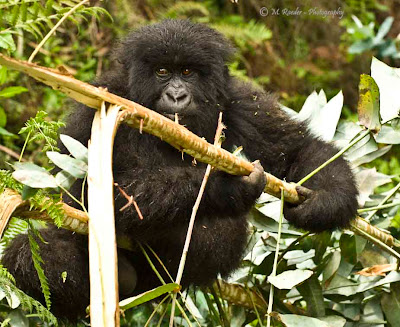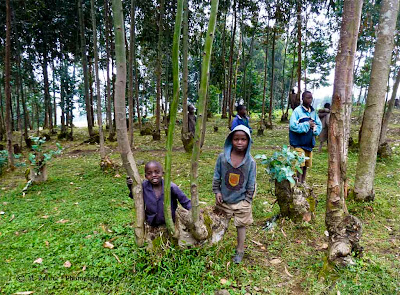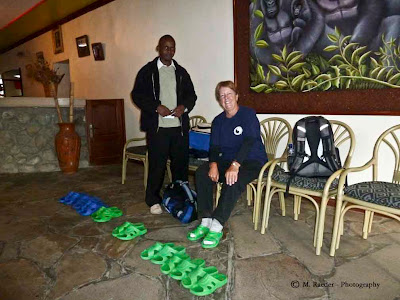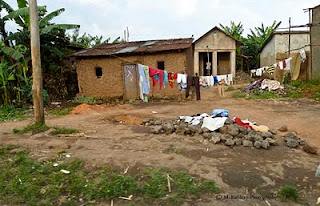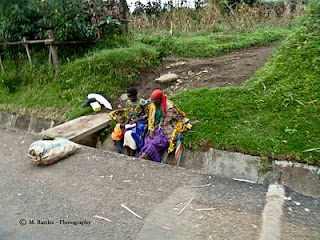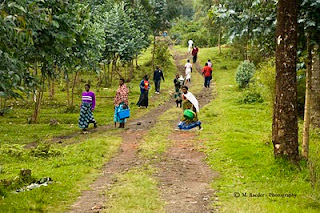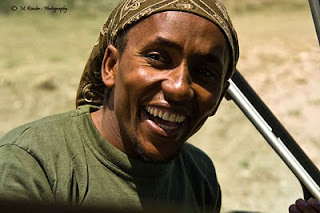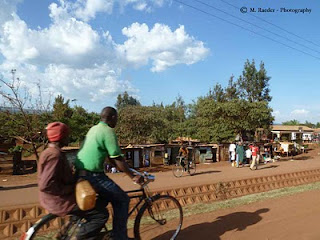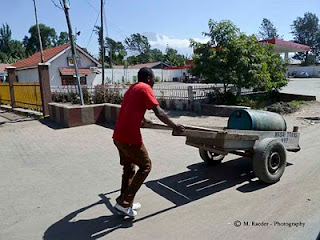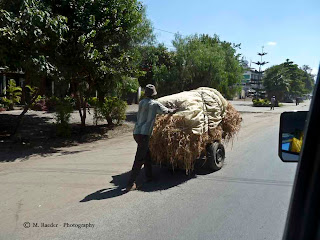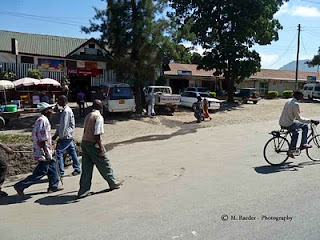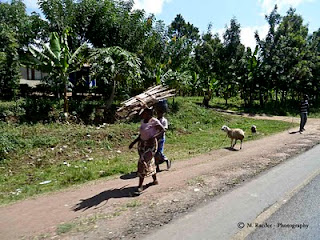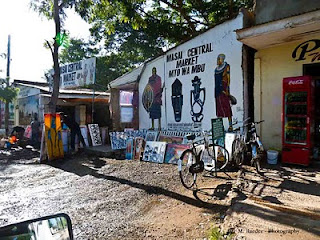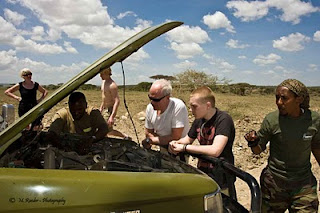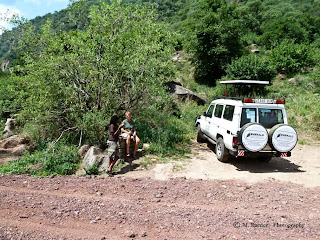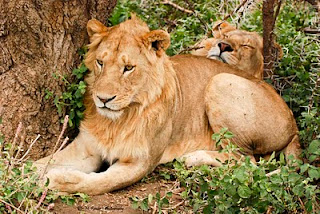Trekking to the Mountain Gorillas in the Vulcano National Park in Rwanda
We are up early with breakfast at 6am and Martin drives us to the Vulcano Park headquarters. This is the meeting place for all trekking in the Vulcano Park. Even before 7am, there are plenty of cars and people, and under a thatched roof, coffee and tea is served. A dozen or so ranger guides in green uniforms seem to have a pow-wow, and the drivers are at the reception area dealing with our permits.
At the Vulcano Park Headquarter: Rangers Briefing in the morning
The mountain gorillas in Rwanda are the last wild mountain gorillas in the world. Following the research that Dian Fossey did here so many years ago, during the last ~15 years gorilla families have been habituated to people, meaning they are living wild in their natural environment but are used to see people coming into their terrain. In principle, they ignore the visitors as long as we are not closer than about 7 meters (~21 ft). Both Rwanda and Uganda are very protective of the gorillas and have encouraged tourism to see the gorillas. On the Rwandan side of the park are about 10 gorillas families that have been habituated. In total there are more gorilla families and some of them are studied for behavioral research. A few families are living wild without any human contact. A gorilla family typically consists of a ‘silverback’, the dominant male, and several females and babies (0-3.5 years) and juveniles (3.5-8 years) and they roam freely in the rain forest of the park. Gorillas are nomadic animals, they built a nest every evening for the nightly rest, then forage the forest for food during the day. Their diet consists of leaves, roots and fruits that they find in their surroundings. Depending on food availability they stay in a relatively small area when it is plentiful or roam larger areas when food is scarce. The gorilla trackers, part of the National Park staff, spend almost every day in the mountains and record their comings and goings. This allows knowing the location of the habituated families. The trackers are also vigilant of poaching activities. Although the gorillas are not typically the target of poaching, illegal snares are set for antelopes and smaller animals that provide food source for the people living in the Vulcano Park surroundings. However, the gorillas fall prey to these snares as well.
In preparation for seeing the gorillas, it is mandatory to obtain a trekking permit. In 2010, 18,450 gorilla trekking permits were granted on the Rwanda side of the Virunda Massive by the park authority. I had secured 3 gorilla trekking permits for the time we are in Rwanda and today is the first day. Visits to the gorillas are in groups of 8 guided by a ranger and an additional tracker with a gun [This is for protection from the wild buffalo and elephants that roam the park]. We are assigned to a ranger and obtain a briefing about the gorilla program, the habituation of the families, which family we are assigned to: We will see the Sabyinyo family with the largest silverback, named Guhondo, and his family. Fidel, our guide, shows us pictures of the silverback (39 years old), his females and the 2nd male in the family, a younger male that is just turning silver at an age around 12 years. There are some youngsters and a 6 month old baby in the group. In our group of eight are an elderly couple for Arizona, 2 German women who work at the Embassy in Kigali, an outdoors magazine writer and a photographer who are researching an article on Burundi and Rwanda, and Linda and I. Our respective drivers take us up the mountain for about 30 minute and Fidel our guide rides with us. At the start of the trek, porters await us with walking sticks – very helpful – and those to wish to have the help of a porter hire one. They will carry our backpacks and also lend a helpful hand in the rugged terrain. And off we go first through the village agricultural area with potato fields in full bloom and goats on the meadows. It takes us about 40 minutes to reach the boundaries of the Vulcano Park, marked by a stone hedge to keep the cattle out and the elephants and buffalo in the park since their destructive behavior is not welcomed by the villages. In the past years, lots of educational efforts have been expended to assure that the country and the local villages support the park and its unique gorilla population. Parts of the permit fees support the villages with financial aid. The porters, who are not employed by the park, are paid individually by the visitors for their service and that brings much needed cash to the village.

Fidel, our ranger on the first day
Walk through agricultural land with potato fields
We climb over the boundary stone wall and the deep ‘moat’ behind it, and find ourselves in a dense bamboo forest which steeply ascends the mountain side. We have a ranger with a gun accompany us as the first in line on the look out for elephants and buffaloes, but we don’t see either of them during our trekking up the mountain. Then Fidel sets the pace for our group. We walk single file with the porters in the back. The path is narrow and later there is no path and we trek through ‘virgin’ territory, vines and bushes being slashed by a machete. It is moist and the shrubbery is lush. Nettles brush against us – slightly stingy! - , and I use walking stick and the bamboo trunks to steady and maneuver through the thickets. We walk mostly under high canopy but also come to open areas where the shrubbery is even denser due to the air and light that support more growth. Our path is mostly upwards but as in all wilderness trekking the terrain goes up and then down again but we are gaining altitude steadily. We walk slowly; stop when necessary to catch our breath. It is quiet no one talks. Only Fidel is occasionally on the walky talky in contact with the trackers who tell him where the gorillas can be found. How one identifies the location in this wild forest, is a mystery to me specifically since we are not trekking on established paths? But about 1.5 hours after entering the park, we stop and listen and we hear the gorillas for the first time. It is a grunting noise and apparently they make this noise when they are comfortable and to communicate and locate each other in this dense forest.
Our group finds a small opening and we prepare for the gorillas by taking our cameras out of the bags, leave the walking sticks and everything we brought behind and only proceed quietly through steep and very dense vegetation and then we see them: the silverback and a younger females resting on a bed of green vegetation not more than 4 meters ahead of us. They are on a steep slope and we try to get a good foothold to observe them. They seem to ignore us although after a bit, the silverback looks at us sleepily. It is an awesome sight. The large male stands about 1.7m when erect and weighs about 200kg. Our guides and the trackers that have joined us for the hour that we are allowed to visit make the grunting noises that seem to keep the gorillas comfortable. As we watch, 2 more gorillas emerge from the forest and just pass through the resting place only to disappear in the thick vegetation.
First Silverback sighting
Silverback looking at us sleepily
Sleeping gorilla
Gorilla - 7 months old
As the 2nd largest male and a mother and a 7-mo old baby are spotted, we descend a bit through very dense forest [I wished I had my walking stick!] and view them resting comfortably under the bamboo with lots of vine hanging down somewhat blocking our view. But we have the opportunity to see the baby playing, swinging on the vines, rolling, jumping on the mother who brushes it away almost as saying, please leave me rest a bit. I could stay for much longer just to watch the interactions and the play. The baby makes faces like an infant and seems very happy to swing, fall down, and climb up again. Just wonderful! But we also hear that the silverback has gotten up and is more fully visible and so we hurry up again over roots and vines and squeeze between huge bamboo trunk to fully see the silverback before he decides to plunge down the steep hill where we later find him in the canopy munching on leaves. He is in a bit of distance but we can see him stripping leaves of the stems and munching peacefully on bits of greens. The 1-hour visitation time goes by very fast and much of the time we stand in awe, until Fidel urges us to go up the mountain side again to where our backpacks are.

Resting a bit after the gorilla visit
Walking back through the potato fields
We pack our bags, rest for a while, all of us silently reflecting on the animals that have given us a glimpse into their daily life in the wild. Our descend from the mountain although slippery and again through nestles and shrubbery goes faster. Thankfully, there were no insects to bug us, just the stings of the nettles that did not last very long. And almost too fast, our first adventure with the gorillas is history. We reach the park boundaries, climb over the stone wall and walk through the potato fields to reach the road and our drivers. Thanks for modern technology, Fidel had phoned ahead and estimated the time we would reach the village.
Villagers selling carved gorillas
Village Children
Fidel hands out certificates of successfully trekking the gorillas
Local folks had set up tables and were showing gorilla carvings and woven baskets for sale. Children had gorilla drawings and were selling them for $1. Fidel awarded all of us with Certificates of Successful Gorilla Trekking, and we thanked and paid our guides and porters. Now that I reflect on this experience, what a privilege to see these gorillas in their natural habitat. There are only ~730 left in the wild and I saw 8 of them! I hope I will dream of them tonight. I hope that conservation efforts will continue and that the political will is there to protect them from the ever encroaching needs of the growing population [Rwanda’s population has grown by 30% in the last 4 years!]. I can only hope that it remains important to protect our close cousins in this world where balance with nature is not necessarily on top of the political agenda!
Driving through the village with mud huts, muddy roads and lots of children
Back at the Mountain Gorilla View Lodge, the friendly staff awaits us at the entrance to take our muddy shoes which will be returned clean in a couple of hours!! Tired, happy, hungry, we sit down for a late lunch and a cold one!
We exchange muddy shoes for slippers






